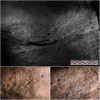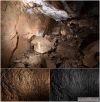Redefining shared symbolic networks during the Gravettian in Western Europe: New data from the rock art findings in Aitzbitarte caves (Northern Spain)
- PMID: 33112862
- PMCID: PMC7592797
- DOI: 10.1371/journal.pone.0240481
Redefining shared symbolic networks during the Gravettian in Western Europe: New data from the rock art findings in Aitzbitarte caves (Northern Spain)
Abstract
The renewal of the archaeological record, mainly through the discovery of unpublished sites, provides information that sometimes qualifies or even reformulates previous approaches. One of the latter cases is represented by the three new decorated caves found in 2015 in Aitzbitarte Hill. Their exhaustive study shows the presence of engraved animals, mainly bison, with formal characteristics unknown so far in the Palaeolithic art of the northern Iberian Peninsula. However, parallels are located in caves in southern France such as Gargas, Cussac, Roucadour or Cosquer. All of them share very specific graphic conventions that correspond to human occupations assigned basically to the Gravettian cultural complex. The new discovery implies the need to reformulate the iconographic exchange networks currently accepted, as well as their correspondence with other elements of the material culture at the same sites. Thus, we have carried out a multiproxy approach based in statistical analysis. The updated data reveals a greater complexity in artistic expression during the Gravettian that had not been considered so far, and also challenges the traditional isolation that had been granted to Cantabrian symbolic expressions during pre-Magdalenian times.
Conflict of interest statement
The authors have declared that no competing interests exist.
Figures


















Similar articles
-
Unravelling the skills and motivations of Magdalenian artists in the depths of Atxurra Cave (Northern Spain).Sci Rep. 2023 Oct 13;13(1):17340. doi: 10.1038/s41598-023-44520-w. Sci Rep. 2023. PMID: 37833336 Free PMC article.
-
Pre-Solutrean rock art in southernmost Europe: Evidence from Las Ventanas Cave (Andalusia, Spain).PLoS One. 2018 Oct 17;13(10):e0204651. doi: 10.1371/journal.pone.0204651. eCollection 2018. PLoS One. 2018. PMID: 30332432 Free PMC article.
-
Divergence in the evolution of Paleolithic symbolic and technological systems: The shining bull and engraved tablets of Rocher de l'Impératrice.PLoS One. 2017 Mar 3;12(3):e0173037. doi: 10.1371/journal.pone.0173037. eCollection 2017. PLoS One. 2017. PMID: 28257445 Free PMC article.
-
U-series dating of Paleolithic art in 11 caves in Spain.Science. 2012 Jun 15;336(6087):1409-13. doi: 10.1126/science.1219957. Science. 2012. PMID: 22700921
-
Microbiological and environmental issues in show caves.World J Microbiol Biotechnol. 2012 Jul;28(7):2453-64. doi: 10.1007/s11274-012-1070-x. Epub 2012 May 11. World J Microbiol Biotechnol. 2012. PMID: 22806150 Review.
Cited by
-
Multivariate analyses of Aurignacian and Gravettian personal ornaments support cultural continuity in the Early Upper Palaeolithic.PLoS One. 2025 Jun 4;20(6):e0323148. doi: 10.1371/journal.pone.0323148. eCollection 2025. PLoS One. 2025. PMID: 40465694 Free PMC article.
-
Unravelling the skills and motivations of Magdalenian artists in the depths of Atxurra Cave (Northern Spain).Sci Rep. 2023 Oct 13;13(1):17340. doi: 10.1038/s41598-023-44520-w. Sci Rep. 2023. PMID: 37833336 Free PMC article.
References
-
- Garate D. New insights into the study of Palaeolithic rock art: Dismantling the ‘Basque Country Void. Journal of Anthropological Research. 2018; 74(2): p. 168–200.
-
- Garate D, Rios-Garaizar J, Rivero O, Elkartea FU. Trois nouvelles grottes ornées à Aitzbitarte (Pays Basque). International Newsletter of Rock Art. 2016; 75: p. 1–5.
-
- Maier A. Population and settlement dynamics from the Gravettian to the Magdalenian. Mitteilungen der Gesellschaft für Urgeschichte. 2017; 26: p. 83–101.
-
- Moreau L. Geißenklösterle. The Swabian Gravettian in its European context. Quartär. 2010; 57: p. 79–93.
-
- Pesesse D. Is it still appropriate to talk about the Gravettian? Data from lithic industries in Western Europe. Quartär. 2017; 64: p. 107–128.
Publication types
MeSH terms
LinkOut - more resources
Full Text Sources

